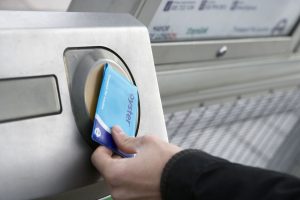Contactless fare payments are still booming on London’s massive public-transportation network, but it’s a different story in the United States despite years of talk and testing.
The latest figures from Transport for London, the agency that oversees the United Kingdom capital city’s subways and buses, show an average of 1.48 million daily journeys on the “Tube” (subway system) and rail were made with contactless cards for the week ending June 29, up 7% from 1.38 million a year earlier. Riders used 934,420 cards for those trips, a 26% increase from 743,141 cards in late June of 2017.
On buses, an average of 976,910 daily trips were made with contactless cards in the week up to June 29, a 15% increase from the 852,569 daily average for the year-earlier week. Cards used for those trips totaled 591,144, up 28%.
A few months ago, TfL officials noted that half of all pay-as-you-go Tube and rail fare payments were made with contactless cards or mobile devices. Mobile devices accounted for one in eight journeys.

Only 112 riders on average used those forms of payment—far less than 1% of UTA’s average of 147,728 weekday boardings as of last December, according to a spokesperson.
Acceptance of general-purpose fare media requires transit agencies to install turnstiles and readers in buses than can process near-field communication signals from the card or smart phone. The UTA began testing general-purpose contactless payments back in 2006 and expanded its NFC options in subsequent years. But low rider usage prompted the agency to review its fare strategy and discontinue acceptance of the mobile wallets and contactless cards on April 1.
“Basically, UTA carefully studied the issue,” the spokesperson tells Digital Transactions News by email. “It would have cost millions to continue to upgrade our system so that it would continue to be compatible with these forms of payment. The cost was deemed unjustifiable.”
Transit consultant Peter Quadagno, chief executive of West Chester, Pa.-based Quadagno & Associates Inc., says London and Salt Lake are such different cities that it’s hard to compare their transit systems. But he does note that U.S. systems haven’t pushed contactless fares the way some foreign cities have.
“There’s not many authorities that have gotten behind the marketing of these things,” Quadagno says.
Instead, a number of systems have turned to mobile fare apps that are popular with Millennials, according to Quadagno. Some of the apps rely on bar-code technology, which reduces the need for capital investments in NFC hardware.
The Chicago Transit Authority discontinued issuance of its contactless-enabled Ventra Mastercard last December, though the system continues to accept contactless fare media. The Southeastern Pennsylvania Transportation Authority in the Philadelphia area continues planning for a new fare system that will include a contactless Mastercard and acceptance of the general-purpose mobile wallets, according to Quadagno.





